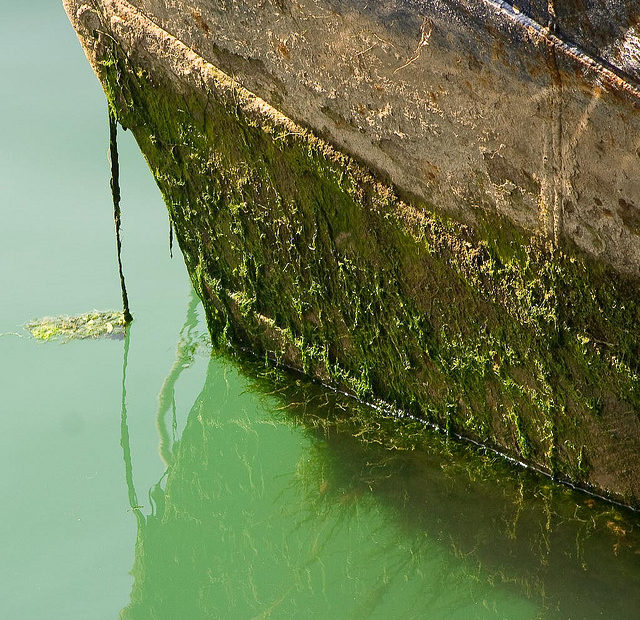Thinking ahead
Eventually, we’ll need to paint the hull. Whatever product we choose, we want it to be something that has the least negative effect on the marine environment. That means a lot of researching and learning about anti-fouling.
For our non-boaty readers, “biofouling” (or, as the cool kids call it, “fouling”) is the accumulation of marine plants, animals and other organisms that gunge up the bottom of a boat. Toward the end of the post, I’ll explain why this is a problem.
Here’s what we’ve learned so far.
Biocides
Let’s jump straight into the deep end and talk biocides.
Most anti-fouling paints contain biocides. These are chemicals that kill organisms or prevents them from growing and reproducing.
Tributyltin, aka TBT, is horrific stuff. From the 1960s to 1990s it was used extensively in anti-fouling paints on recreational, commercial and merchant vessels. TBT causes “imposex” in the females of certain sea snails. In other words, the female snails develop male sex organs and eventually become sterile. TBT accumulates in sediment and releases slowly over decades causing further aquatic environmental harm.
In the 1990s, the International Maritime Organization (IMO) drafted a resolution recommending governments to ban the use of TBT in anti-fouling paints, particularly on non-aluminum vessels under 25 metres, or 82 feet. Some governments around the world have banned its use. Other places continue to use it, such as in the Caribbean. It’s also still used on commercial vessels because it’s so effective. Here’s a fun read from the IMO: IMO Anti-fouling systems paper (OK, it’s not really that fun, but it’s interesting.)
Copper has been used for centuries on boat bottoms. In the past, ships were sheathed in copper; now, paints with copper additives is used. Copper is effective and less toxic than TBT. But copper has negative environmental consequences too. It leaches cuprous oxide into the water. This is linked to impaired function of the olfactory receptor neurons in fish, particularly affecting salmon’s sense of smell and inhibiting their ability to migrate, locate spawning grounds, and avoid predators. As of 2020, Washington State banned the use of copper anti-fouling paints because of the cumulative effects it was having in marinas and on Pacific salmon. An example of the negative effects of copper in the marine environment is the Britannia Mine in British Columbia. At one point, it was the largest copper mine in the British Empire. The effects it had on Howe Sound is still felt today, over 40 years since it was closed in 1974. Here’s an article about the Impacts of Copper on Aquatic Ecosystems and Human Health.pdf. And here’s a link about the contamination from the Britannia Mines: Britannia Mine Contamination
Other biocides we’ve come across include cuprous thiocyanate (“white copper”), tralopyril, and zinc pyrithione.
Tralopyril is the main ingredient in “ECONEA,” which is promoted as environmentally friendly. It appears to be shorter lived than either copper or TBT. Here’s some fun info on tralopyril for your reading pleasure: Chemical Identification and Use for 2,4-D
Paint characteristics
There are ablative paints, meaning the paint sloughs off. A little piece of paint falls off when a critter attaches itself to it, and the piece of paint, and the critter drop to the bottom of the sea. Biocides continue to be released as the paint wears down until there’s no pain left in places on the hull.
There are hard paints that leach biocides over time. They don’t slough off, they leach their toxicity steadily over time.
There are slippery paints with silicone or Teflon that makes it hard for organisms to stick to. And there are paints with microscopic spikes, so the barnacle or mussel larvae don’t attach themselves to it.  It’s like spikey bird deterrents. Anti-fowling.
It’s like spikey bird deterrents. Anti-fowling.
Some paints are UV sensitive, others aren’t.
There’s ultrasonic anti-fouling devices. These attach to the hull and create ultrasonic waves that move the water molecules over the hull, preventing organisms from attaching to it. There are devices that produce mild electrical currents around the hull, designed to disrupt sea life from attaching to the bottom of the boat.
Anti-fouling benefits
The benefits of anti-fouling are that by keeping organisms from growing on the bottom of the boat, the boat slips through the water smoothly and the boat doesn’t get bogged down from the added weight. The boat is more fuel efficient or has better sailing performance. Otherwise, if it was fouled up, the boat wouldn’t be hydrodynamic and it would have a tough time pushing all that weight through the water.
Doing our part
We’re doing what we can to minimize our environmental impact on land, and now on sea. What we decide to use for anti-fouling paint is just one part. We have a lot to learn.
